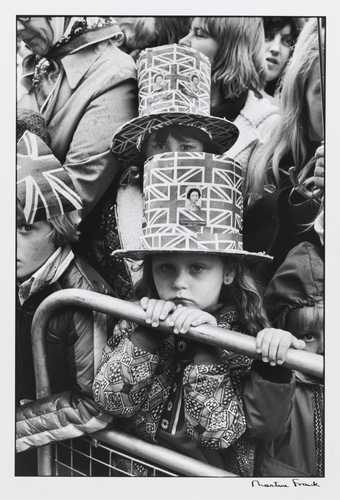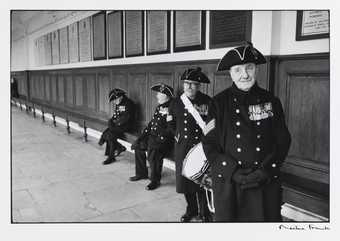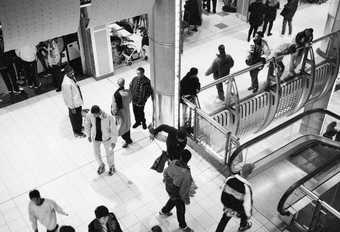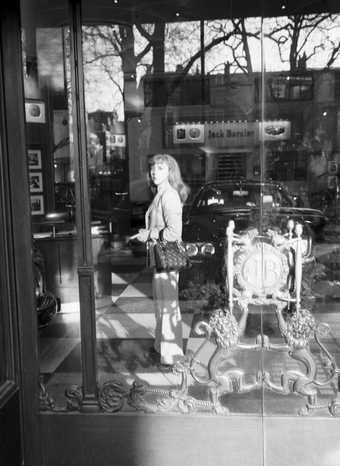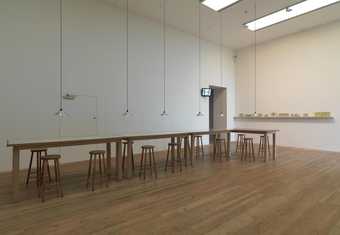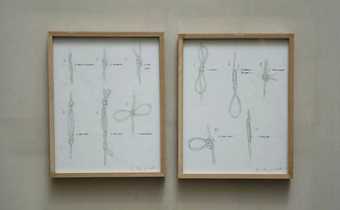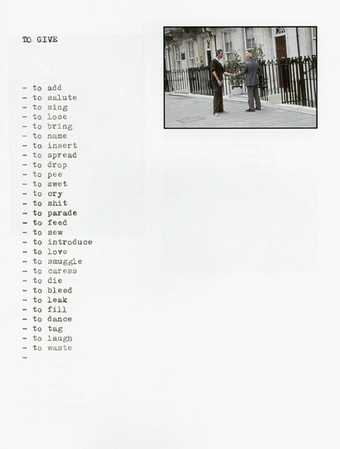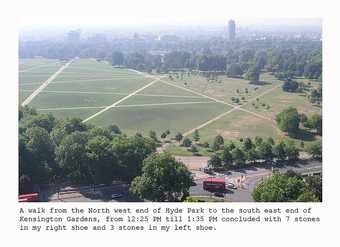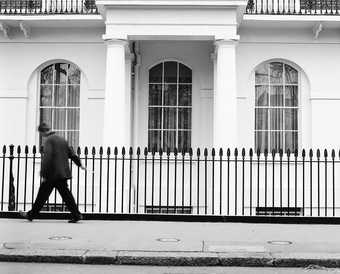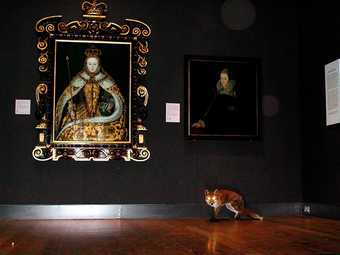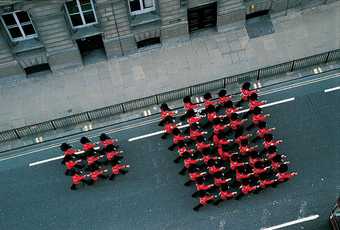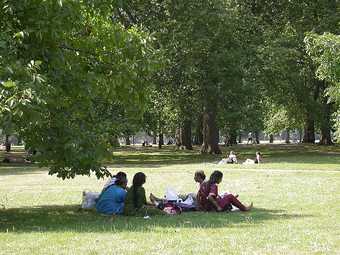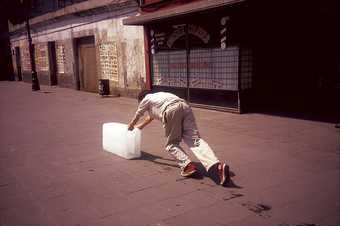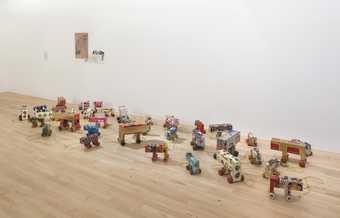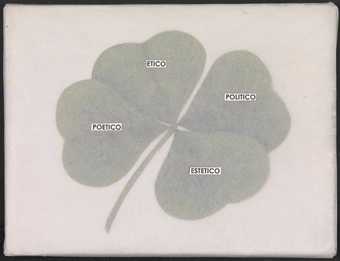
Not on display
- Artist
- Francis Alÿs born 1959
- Medium
- Oil paint on canvas, photograph, gelatin silver print on paper, ink on paper and 18 drawings
- Dimensions
- Overall display dimensions variable
- Collection
- Tate
- Acquisition
- Purchased 2006. The Artangel Collection at Tate
- Reference
- T12183
Summary
The Commuters is an installation by the Belgian-born artist Francis Alÿs. It is comprised of an oil painting, which depicts the legs of people as they walk through London, and eighteen photographs. The painting and photographs are accompanied by a framed work on A4 paper entitled ‘THE COMMUTERS, London 26 Sept – 20 Nov 2005’. Beneath this title are a set of typewritten bullet points which provide instructions for the fate of the painting. The instructions outline that the painting is to be removed from 21 Portman Square at 7pm and taken away by a visitor. It will then remain with the visitor until 11am the following morning, when it is to be returned to Portman Square. This sequence is then to be repeated. The eighteen photographs show the oil painting in various places, such as strapped to the back of a moving motorbike, propped against a sofa in a domestic space, and being carried under the arm of a man down one of London’s Regency streets. The painting, photographs and work on paper that make up this work are hung together in a vertical line.
Alÿs created The Commuters for his 2005 exhibition Seven Walks at 21 Portman Square. This exhibition contained the documentation of actions he had undertaken in London over several years. The Commuters invited visitors to the exhibition to participate in their own action. An oil painting by Alÿs was taken home each day by a visitor to the exhibition, removing the work from a public space to be taken into a private one. The resulting photographic documentation displays the assorted journeys on which the painting was taken each evening, and in so doing demonstrates the diverse ways of living that coexist in the city. The mischievous risk-taking that characterises The Commuters pervades Alÿs’s practice, which recalls the work of the surrealists. Alÿs’s artistic lineage has been traced by the art critic Mark Irving:
This kind of playfulness owes something to René Magritte and other exponents of the Surreal but it’s this delight in creating narratives of the possible and even the absurd that allies Alÿs more closely to short-story writers such as Italo Calvino and Jorge Luis Borges. For him, as for them, the city is a place of fantasy.
(Irving 2005, accessed 5 March 2016.)
Alÿs’s typewritten instructions for this piece ends ‘the next morning’, a clause which trails off to invite the viewer to consider the work unfinished, and imagine future iterations. In keeping with the traditions of happenings and Fluxus, the work provides a poetic score for future actions. This is characteristic of Alÿs’s practice and has been described further by the writer David Toop:
Ambiguities exist in Alÿs’s work, particularly in the question of documentation that haunts performance … The pages seem to function as a kind of notation in which future actions can be imagined, yet they also seem to be at the heart of the work. Everything is here, and we can imagine outcomes, or sense what might be, or what might have been.
(Toop in 21 Portman Square 2005, p.66.)
The Commuters is one of nine works in Tate’s collection from Francis Alÿs’s series Seven Walks. The series was created over the course of six years, as Alÿs wandered the streets of London and mapped its habits, rhythms and rituals in a range of different media. In 2005 the resulting films, videos, paintings, photographs and drawings became Seven Walks; works which either documented the artist’s own walks or those enacted by others on his behalf. The art critic Coline Milliard has stressed how the series humanises the city in which it was made:
Alÿs’s walking creates a ground-level image of the city, fragmented, subjective and incomplete. It claims space for the fragile, the ephemeral and the poetic. In a commuter city where pedestrianism fights for survival, ‘Seven Walks’ transforms increasingly alienating surroundings into a new space tailored to human dimensions.
(Milliard 2010, p.4.)
Alÿs has used walking as an impetus for his work throughout his career, including in early pieces such as The Last Clown 1995–2000 (Tate T07993) and Pebble Walk 1999 (Tate T12193). Other works in the Seven Walks series include Sunny/Shady 2004 (Tate T12197), Railings 2004 (Tate T12194) and The Nightwatch 2004 (Tate T12195).
Further reading
Francis Alÿs: Seven Walks, London 2004–5, exhibition catalogue, 21 Portman Square, London 2005.
Mark Irving, ‘A Walk on the Wild Side’, Times, 24 September 2005, http://www.thetimes.co.uk/tto/arts/article2402962.ece, accessed 5 March 2016.
Coline Milliard, ‘Walks of Life’, Art Monthly, vol.337, June 2010, pp.1–4.
Phoebe Roberts
March 2016
Does this text contain inaccurate information or language that you feel we should improve or change? We would like to hear from you.
Explore
- architecture(30,960)
- periods and styles(5,198)
-
- Georgian(255)
- townscapes / man-made features(21,603)
- fine arts and music(3,982)
-
- picture(248)
- actions: postures and motions(9,111)
-
- walking(607)
- carrying / holding(866)
- man(10,453)
- UK countries and regions(24,355)
-
- England(19,202)
- London - non-specific(3,659)
You might like
-
Martine Franck Greenwich, London
1977 -
Martine Franck Chelsea Royal Hospital, London
c.1973, later print -
Henry Bond Untitled from Point and Shoot
1999 -
Henry Bond Untitled from Point and Shoot
1999 -
Francis Alÿs The Last Clown
1995–2000 -
Francis Alÿs Knots
2005 -
Francis Alÿs Pebble Walk
1999 -
Francis Alÿs Railings
2004 -
Francis Alÿs The Nightwatch
2004 -
Francis Alÿs Guards
2004 -
Francis Alÿs Sunny/Shady
2004 -
Francis Alÿs Ice 4 Milk
2004–5 -
Francis Alÿs Collectors
2006 -
Francis Alÿs Untitled
2000–10

